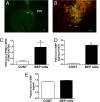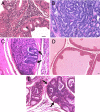Cyclic adenosine monophosphate differentiated beta-endorphin neurons promote immune function and prevent prostate cancer growth
- PMID: 18562281
- PMCID: PMC2449372
- DOI: 10.1073/pnas.0800289105
Cyclic adenosine monophosphate differentiated beta-endorphin neurons promote immune function and prevent prostate cancer growth
Abstract
Pituitary adenylate cyclase-activating peptide (PACAP), a cAMP-activating agent, is highly expressed in the hypothalamus during the period when many neuroendocrine cells become differentiated from the neural stem cells (NSCs). Activation of the cAMP system in rat hypothalamic NSCs differentiated these cells into beta-endorphin (BEP)-producing neurons in culture. When these in vitro differentiated neurons were transplanted into the paraventricular nucleus (PVN) of the hypothalamus of an adult rat, they integrated well with the surrounding cells and produced BEP and its precursor gene product, proopiomelanocortin (POMC). Animals with BEP cell transplants demonstrated remarkable protection against carcinogen induction of prostate cancer. Unlike carcinogen-treated animals with control cell transplants, rats with BEP cell transplants showed rare development of glandular hyperplasia, prostatic intraepithelial neoplasia (PIN), or well differentiated adenocarcinoma with invasion after N-methyl-N-nitrosourea (MNU) and testosterone treatments. Rats with the BEP neuron transplants showed increased natural killer (NK) cell cytolytic function in the spleens and peripheral blood mononuclear cells (PBMCs), elevated levels of antiinflammatory cytokine IFN-gamma, and decreased levels of inflammatory cytokine tumor necrosis factor-alpha (TNF-alpha) in plasma. These results identified a critical role for cAMP in the differentiation of BEP neurons and revealed a previously undescribed role of these neurons in combating the growth and progression of neoplastic conditions like prostate cancer, possibly by increasing the innate immune function and reducing the inflammatory milieu.
Conflict of interest statement
The authors declare no conflict of interest.
Figures





References
-
- Settle M. The hypothalamus. Neonatal Netw. 2000;19:9–14. - PubMed
-
- van Eerdenburg FJ, Rakic P. Early neurogenesis in the anterior hypothalamus of the Rhesus monkey. Brain Res Dev Brain Res. 1994;79:290–296. - PubMed
-
- Altman J, Bayer SA. Development of the diencephalon in the rat. III. Ontogeny of the specialized ventricular linings of the hypothalamic third ventricle. J Comp Neurol. 1978;182:995–1015. - PubMed
-
- De A, Boyadjieva N, Pastorcic M, Reddy BV, Sarkar DK. cAMP and ethanol interact to control apoptosis and differentiation in hypothalamic β-endorphin neurons. J Biol Chem. 1994;269:26697–26705. - PubMed
-
- Plotsky PM, Thrivikraman KV, Meaney MJ. Central and feedback regulation of hypothalamic corticotropin releasing factor secretion. Ciba Found Symp. 1993;172:59–75. - PubMed
Publication types
MeSH terms
Substances
Grants and funding
LinkOut - more resources
Full Text Sources
Medical
Miscellaneous

